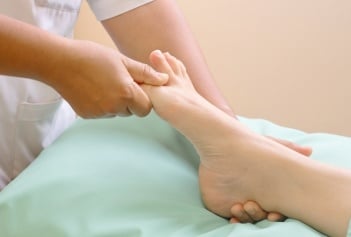Baton Rouge Orthopedic Surgeon: Bunion Pain is Treatable and Potentially WITHOUT Surgery

5 Tips for Soothing Bunion Pain:
What to do about that large, painful bump beside and under your big toe joint? You may have noticed a bony growth, perhaps painful or reddened, growing in size by your big toe. You might have had trouble fitting your foot into those sassy pumps you used to love or are having trouble finding attractive shoes for a special occasion. It is likely that you have what is known as a bunion. In more precise terms, due to genetics or physical attributes of your particular foot, the base of the big toe, known as the metatarsophalangeal joint, juts out from the angle of the foot and changes the direction of your great toe.
Surgery is the definitive choice for bunion treatment and involves restoring the toe to a more normal position, but at Warner Orthopedics and Wellness, Dr. Meredith Warner will evaluate other non-operative measures to alleviate the pain and help stop the progression of the bunion before committing to surgery. This can become a painful and debilitating condition if left untreated, changing the other toes on that foot, and causing you to develop thick calluses (those rough patches under the sole of your foot where you bear your weight). Conservative measures involve taking the pressure off of the painful joint, changing the mechanics of your foot, and protecting that painful bump! For this, you need the right kind of shoe, and maintaining a healthy weight can help as well.
1. If possible, you should purchase a shoe with a wide, flexible sole, with extra room in the toe area to fit the bunion. More narrow shoes can be altered with stretchers to make room for the bunion. Low heels will be less painful due to the physics of weight-bearing. Soft-leather shoes and sandals are good options.
2. Many drugstores carry gel pads or moleskin pads that can be placed in the shoe to protect the bunion. Foam or lamb’s wool spacers can be placed between the toes to relieve some pressure.
3. A physician may prescribe special orthotics (shoe inserts) to position the foot appropriately during activity. These prescription inserts can help slow progression of the disorder. In addition, try out cycling, swimming, and other low-impact exercises to maintain good health instead of running.
4. When this bony area becomes irritated, red, and painful, you can try soaking the foot in warm water, ice packs, and over the counter pain relief medications, such as Tylenol, or non-steroidal anti-inflammatory medications, including Ibuprofen or Aleve. Avoid overuse of these medications since they can irritate your stomach and come with other side effects, but may be appropriate for temporary relief.
5. Some physicians choose to inject steroids into this area which may relieve pain by reducing the inflammation temporarily, but this option carries a lot of side effects when used too often, such as weakening the ligaments in this joint.
Image courtesy of Praisaeng / FreeDigitalPhotos.net
Dr. Meredith Warner is a board certified, Fellowship Trained Foot and Ankle, Orthopedic surgeon practicing in Baton Rouge, Louisiana. Dr. Warner is committed to offering her patients an accurate diagnosis along with a comprehensive treatment plan in order to get them back to a pain free life. Dr. Meredith Warner specializes in the treatment of orthopedic issues, providing operative and non-operative treatment plans of orthopedic problems, including musculoskeletal pain such as chronic back, neck and foot pain, reconstructive surgery of the foot and ankle, arthritis, diabetic, hammer toe, bunion, wound care, work injuries, fitness and nutrition and osteoporosis issues.





